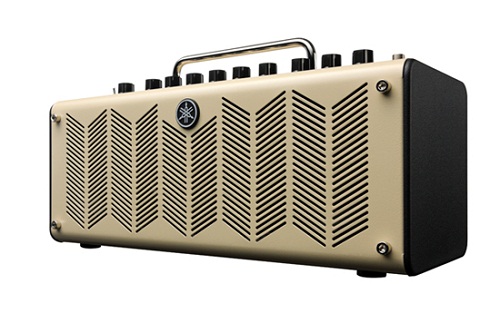Review: Yamaha THR10 Modeling and Recording Amp

The following content is related to the September 2012 issue of Guitar World. For the full range of interviews, features, tabs and more, pick up the new issue on newsstands now, or in our online store.
Small amps are almost as common today as hillbilly reality shows, but Yamaha has come up with a little powerhouse so unusual and distinctive that it stands out from the pack. Dubbed the THR10, this impressively versatile stereo 10-watt (dual five-watt) combo features two eight-centimeter full-range speakers, tube-amp tone, digital amp models and effects, storable presets, USB connectivity, and a choice of battery or AC operation, all in an attractive retro-styled metal housing.
FEATURES
- The first thing you’ll notice about the THR10 is its cream-colored chassis with a distinctive cutout chevron-pattern grille. When the amp is powered up, the grille illuminates with a simulated tube-like orange glow that emphasizes the THR10’s vintage styling.
- Despite appearances, the THR10 is a digital amp that uses Yamaha’s Virtual Circuitry Modeling (VCM) technology to create five guitar amp models (Clean, Crunch, Lead, Brit Hi and Modern), a bass amp model, an acoustic amp model and a flat setting for use with an iPod or other stereo music player. VCM is also behind the THR10’s impressive selection of effects, which comprises chorus, flanger, phaser, tremolo, delay, delay/reverb, spring reverb, hall reverb, compressor and noise gate. There are controls for gain, master volume and three-band EQ (bass, middle, treble) as well as separate output controls for guitar and USB/auxiliary sound sources.
Five memory locations let users save their favorite amp, EQ and effect settings. Using a computer and the THR Editor software, you can modify numerous parameters in even greater detail, as well as the noise gate and compressor effects, which are accessible only via the THR Editor. A tap-tempo function and a tuner are also available from the THR10’s front panel.
PERFORMANCE
Despite its small size, the THR10 sounds big, delivering punchy bass and impressive volume comparable to that of a much larger amp. The various amp models do their jobs quite nicely, with the Clean setting providing distortion-free output even with all the controls maxed, the Crunch setting producing moderate overdrive that cleans up when you back down the guitar’s volume knob, and the Lead, Brit Hi and Modern settings delivering the responsive feel of a raging tube amp. The EQ section can dial in a wide variety of tones that never sound artificial or overly harsh. The effects are very useful—using the THR Editor I was able to dial in brisk Edge-like delays and mammoth EVH-style delay/reverb/phaser brown sounds.
Get The Pick Newsletter
All the latest guitar news, interviews, lessons, reviews, deals and more, direct to your inbox!
Chris is the co-author of Eruption - Conversations with Eddie Van Halen. He is a 40-year music industry veteran who started at Boardwalk Entertainment (Joan Jett, Night Ranger) and Roland US before becoming a guitar journalist in 1991. He has interviewed more than 600 artists, written more than 1,400 product reviews and contributed to Jeff Beck’s Beck 01: Hot Rods and Rock & Roll and Eric Clapton’s Six String Stories.
"I never use my tube amp at home now, because I have a Spark Live": 5 reasons you should be picking up the Positive Grid Spark Live in the massive Guitar Month sale
“Our goal is to stay at the forefront of amplification innovation”: How Seymour Duncan set out to create the ultimate bass amp solution by pushing its PowerStage lineup to greater heights










